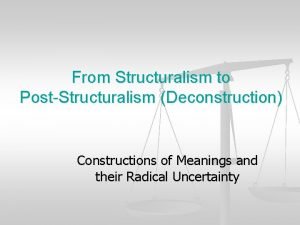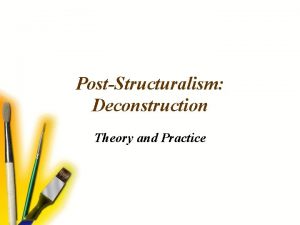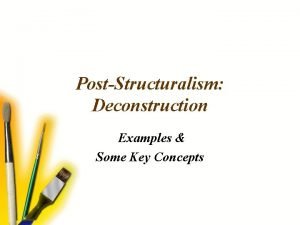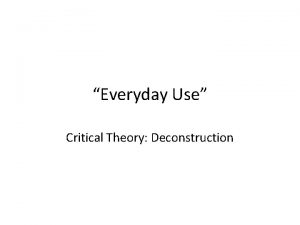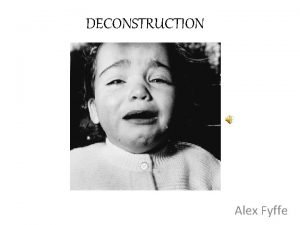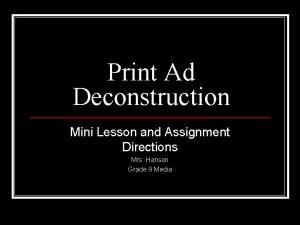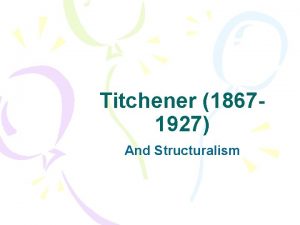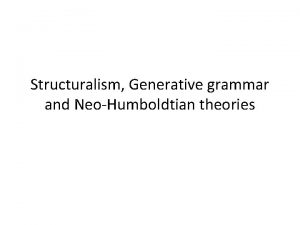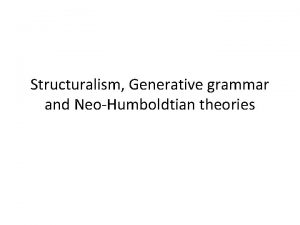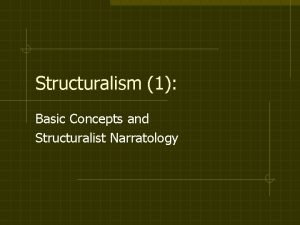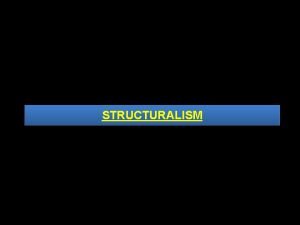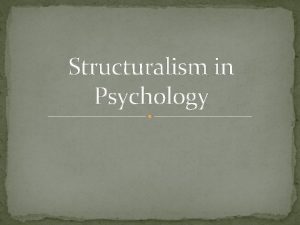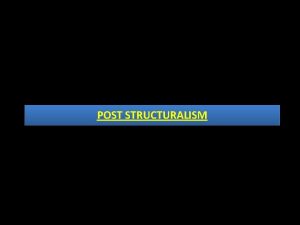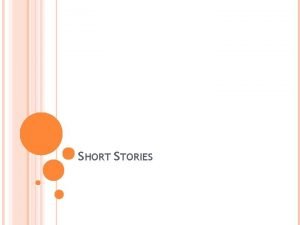Critical Theories Structuralism and Deconstruction Short Story Everyday











- Slides: 11

Critical Theories: Structuralism and Deconstruction Short Story: “Everyday Use”

A Brief Introduction to Structuralism • In order to understand Deconstruction, let’s talk for a moment abut Structuralism, which claims… – Every word/idea only gets its significance from its relationship to other words/ideas. – This complex web of relationship creates a stable structure that can be described and understood. – Claims that meaning is stable in literary works.

More on Structuralism • The words we use to designate objects or ideas ONLY make sense in the context of our entire language system and will not be understood as meaningful to someone who does not know that language system. – This is true for what we usually think of as a “language” (Spanish or English or German or Japanese) but is ALSO true for specialized vocabulary within a single language—such as medical jargon or teen slang or African American Vernacular (sometimes called Ebonics) or even the complicated academic vocabulary used by a textbook or a theorist. – These other “language systems” must be LEARNED the same way a second language is learned. – If you have ever found yourself thinking “I have NO CLUE what this is saying” when you are reading something in your own language, its because you haven’t learned the language system for that subculture!


Literary Structuralism • So how to we apply this study and understanding of language and linguistics to literature? – First off, it gives us the understanding that words only mean what they mean because we agree they mean it. Therefore it follows that groups of words (poems, novels, plays, whatever) are the same. • Literary Structuralism asks readers to think of poems, short stories, novels, and plays NOT as self-contained and individual works that have some kind of inherent meaning –like little islands with one interpretation—but as part of a larger system of literature. – To fully appreciate and analyze a work, the reader must understand the system that it is a part of. • That is, if you are reading a poem you have to know something about the rules of poetry • If you are reading a short story, you have to know the something about the conventions of the short story form. • In order to truly appreciate or criticize a science fiction novel, or a fantasy tv show, or a teen romance novel, you should know something about the tropes of that genre.

What is Deconstruction? • In Structuralism, once you learn the system of language and the system of literature you are working with, you can understand the meaning of a work. • HOWEVER, the literary theory of Deconstruction rejects the Structuralist idea that any literary work can have a stable or “closed” meaning. • Deconstructionists say that if language functions by arbitrarily connecting words (signifer) to ideas/things (signified), this means that language itself is inherently UNSTABLE. • Things only mean things because we believe they mean those things. AND they only have that meaning in this specific culture and language and at this specific point in time and history. [LINK] • Deconstructive critics look at the way that plural, multiple meanings occur in works of literature, and how those multiple meanings interact with one another. • Deconstructive critics also look for ways in which either/or readings (usually about pairs of opposites called binaries) in a text break down or become unstable. • Deconstructionists say that no work of literature has one meaning, and any meanings that do exist are constantly “open” and unstable.

A Bit More on Deconstruction • Read section on Derrida from the textbook • “A” and “Not-A” – Binary/binarism • Democracy/Non-Democratic • Us/Them • Man/Woman – Interesting Linguistic Note: the original Old English words for man and woman were “wermann” and wifmann”, with “mann” being completely gender neutral word meaning “person” or “human” – BUT as societies became more patriarchal, the default “person” or “human” was thought to be male so the word for “person” (mann) came to mean “male person” exclusively and woman, instead of being her own category, became “not-man”

What questions might Deconstructive Critics ask? • What ideas or characters seem to be in opposition in this work, and how does the work privilege or avoid privileging one of them? • How does the work create ambiguity and multiple meanings? • What interpretive possibilities are presented by this ambiguity? • How do various possible meanings presented by the text support or undermine each other?

Questions to Begin Our Deconstruction Discussion of “Everyday Use” Questions for the whole class: 1. What are some of the ideas or people that seem to be in opposition in this short story? • To put this another way, where is there conflict between opposites?

Group Discussion Questions for “Everyday Use” p. 312 1. Does the text (not the narrator…) “take sides”? Why or why not? What multiple meanings does this story produce? 2. How does this story deal with the “everyday use” vs. the “reverence/preservation” binary (remember, a binary is a pair of opposites)? 1. Does it privilege one over the other? 3. Were there points in the story when your sympathy was with the narrator and Maggie? With Wangero (Dee)? 4. Can we understand the quilts themselves as a sign that is understood differently by each sister? BONUS QUESTION: 1. In your opinion: who should have gotten the quilts?

For Thursday: • Tuesday, May 5 Topics: Feminist Critique and Gender Studies/Queer Theory. Also, how to cite sources and avoid plagiarism. Homework Due: – Read “Feminist Criticism” overview p. 1217 -1219 – Read “Queer Theory” overview p. 1232 -1234 – Read Short-Short Story: Jamaica Kincaid’s “Girl” p. 79 – Read Poem: Adrienne Su “The English Canon” p. 474 ALSO – Research Paper Progress Check: Bring rough draft of introduction/thesis and at least 2 sources.
